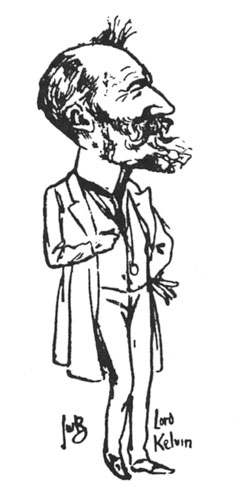Degrees Kelvin, Why We Do It and more...
By Robert Dorit, David Schneider, Christopher Brodie, Amos Esty
Short takes on five books
Short takes on five books

DOI: 10.1511/2004.50.0
Lord Kelvin, it seems, is best remembered for being forgotten. The first scientist to be elevated to the peerage, he was buried next to Newton in Westminster Abbey. But in a recent poll, British physicists failed to rank him even among the top 10 of their number. Why has his star fallen so far?

From Degrees Kelvin.
In Degrees Kelvin: A Tale of Genius, Invention, and Tragedy (Joseph Henry Press, $27.95), astrophysicist and science popularizer David Lindley shows that Kelvin's mind was perfectly attuned to the clockwork elements of classical physics: heat, light, electricity and magnetism. But as Newton's universe began to waver in the new century, Kelvin clung to his old views, meeting new ideas with increasing mistrust, resistance and denial.
By then Kelvin was an old man, and perhaps he can be forgiven for trusting the ground he knew. Lindley wisely refrains from drawing pat conclusions and concentrates instead on the lasting products of Kelvin's gigantic energy: brilliant theoretical insights into electromagnetism and thermodynamics, and valuable shirtsleeve work, particularly on a submarine telegraph cable and a reliable marine compass. "Uniquely, Kelvin existed in both spheres," Lindley notes, "a philosopher and a practical man rolled into one."—G.R.
Given that "Cold Cape Cod clams, 'gainst their wish, do it / Even lazy jellyfish do it," shouldn't evolutionary biologists have already figured out why almost every multicellular species reproduces sexually? Maybe so, but we're not sure. Why bother making offspring with a partner—and thus sharing only half your genes with your children—when asexual reproduction ensures that babies carry 100 percent of the parent's genes?
Niles Eldredge, in Why We Do It (W. W. Norton, $24.95), takes a perspective that encompasses deep time and deep patterns in the fossil record. His answer? Sex prevails because species that engage in it, on average, resist extinction and give rise to new species more often than do their asexually reproducing counterparts. Sexual reproduction is, in effect, a hitchhiker, incidentally carried along to predominance by processes occurring at the species level. The "ultra-darwinian" notion that all of nature is the struggle of genes to make copies of themselves is replaced with a more nuanced view: Genes are just chroniclers of the rising and falling fortunes of the species in which they are found.
This book, meant for nonspecialists and informal almost to a fault (the multiple mentions of "humping" grate), comes as a welcome antidote to the raft of books providing evolutionary rationales for every aspect of human behavior, from philandering to capitalism. Nature, Eldredge reminds us, is organized much like those nested Russian dolls: genes within cells within organisms within populations within species. This hierarchy guarantees that events at one level affect all the others, greatly complicating the search for a single causal layer. We live in an age that wants to privilege genes as the real currency of evolution, but the very history of life argues for a more encompassing view.—R.D.
Should you be worried about the threat of black holes to your continued existence? Have you ever wondered why some birds stand on one leg while they sleep? And what, exactly, is the difference between a level I and a level II multiverse? The answers to these and many other questions can be found in the eclectic and entertaining mix of essays that editor Steven Pinker has crammed into The Best American Science and Nature Writing 2004 (Houghton Mifflin, $27.50, cloth; $14, paper). Pick up this volume and you'll find a short, witty explanation of how to avoid upsetting an introvert, longer profiles of medical and scientific pioneers, and a great deal more.
To its credit, the collection tackles head-on some of the current cultural and political debates surrounding scientific work. Covering a diverse range of topics, the pieces share a disregard for opinions that, although widely held, do not stand up to close examination. Thus we read that suicide bombers are neither inherently "evil" nor simply the product of poverty and lack of education. Another essay discusses the implications of Iraqi marriage practices for the process of democratic nation building. Multiple articles assess the perceived threats of genetic engineering. It may be impossible to identify a single common theme, but certainly Pinker has succeeded in his quest to find writing that has both style and substance.—A.E.

From Gravity from the Ground Up
You've probably often seen diagrams that show space as a rubber sheet being warped by bowling ball-like masses. But who can really claim a solid understanding of this modern view of gravity? Those who want to get a better grasp of it without having to wrestle with the mathematical details of general relativity should pick up Bernard Schutz's Gravity from the Ground Up: An Introductory Guide to Gravity and General Relativity (Cambridge University Press, $45), which is delightfully thorough yet easy to read. Schutz nurtures an intuitive understanding of the subject, relegating more quantitative descriptions to sidebars. His book is full of historical detail. He describes, for example, a toy given to Einstein, containing a ball on a string that in turn is attached to a weak spring, one not quite strong enough to draw the ball up into a cup. This gadget is suitable for demonstrating the equivalence principle: To capture the ball, just make it "weightless" (for a brief time) by letting the toy free-fall. Astronauts in training experience temporary weightlessness similarly, on aircraft sent along a parabolic, free-fall trajectory (above).—D.A.S.
Whose View of Life? (Harvard University Press, $27.95), Jane Maienschein's book about the ethical debates over cloning and its equally provocative siblings, stem cell research and gene therapy, has much to recommend it: accessibility, fine-grained detail, thoughtful analysis and a grand historical sweep. The discussion leaps from Aristotle (the debates have their intellectual roots in ancient Greece) to Arthur Caplan (perhaps the most quoted bioethicist working today), from Leonardo da Vinci to Wilhelm His (whose techniques and practices shaped modern human embryology), from geneticist Thomas Hunt Morgan to Ian Wilmut (who cloned the sheep Dolly). At the crux of the debate is nothing less than the nature of life, a slippery, superstition-plagued subject. But Maienschein provides readers with the scientific background and the social and political context needed to understand the issues. The result is part textbook on the new biology, part horror story of the nearsightedness of public policies, and part extended op-ed calling for a more reasoned approach. This is a first-rate volume for philosophers (armchair or professional) as well as scientists, but it may appeal most to biologists who, because of the current trend toward microspecialized research, may have missed bits and pieces of a story that concerns them greatly.—C.B.
Click "American Scientist" to access home page
American Scientist Comments and Discussion
To discuss our articles or comment on them, please share them and tag American Scientist on social media platforms. Here are links to our profiles on Twitter, Facebook, and LinkedIn.
If we re-share your post, we will moderate comments/discussion following our comments policy.